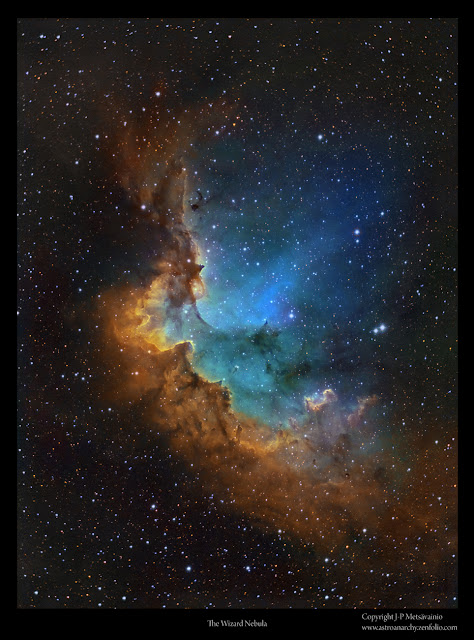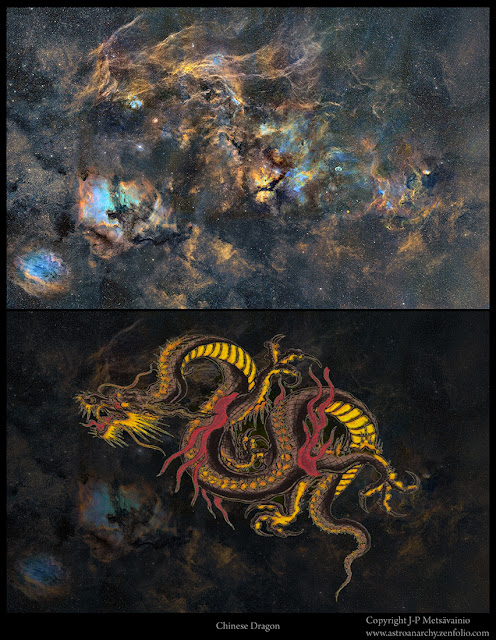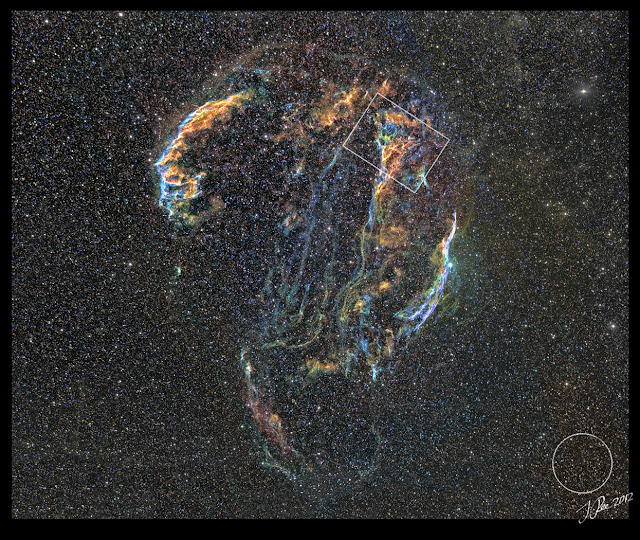COPYRIGHT, PLEASE NOTE
All the material on this website is copyrighted to J-P Metsavainio, if not otherwise stated. Any content on this website may not be reproduced without the author’s permission.
BUY A MUSEUM QUALITY POSTER
BUY A POSTER:https://astroanarchy.zenfolio.com/
Tuesday, September 3, 2013
Time and Space Puzzle
I made this just for a fun...
INFO
Image in the puzzle above shows my image of the Bubble nebula in constellation Cassiopeia.
More info about this nebula in this blog post:
http://astroanarchy.blogspot.fi/2011/03/bubble-nebula-reprocessed.html
Friday, August 30, 2013
Wonders of Gemini
The collection
I made a collection out of my images from the constellation Gemini. Pictures are taken between 2007-2013 with different instruments. Closeups are taken with my longer focal length instrument, an old Meade LX200 12" telescope. Wider field images are taken by using two camera lenses, Tokina AT-X 300 f2.8 and Canon EF 200mm f1.8 lens, both full open. All images are shot with QHY9 astronomical camera and the Baader narrowband filter set, H-alpha, Oxygen and Sulfur.
Be sure to click the image to see it in full scale!
Note. a large image, ~5MB and 1900x3200 pixels
Technical data and other information
You will found all the images in this collection from my portfolio, with technical details.
Orientation
Labels:
Narrowband color images,
nebula
Wednesday, August 28, 2013
Wonders of Perseus
The collection
I made a collection out of my images from the constellation Cepheus. Pictures are taken between 2007-2013 with different instruments. Closeups are taken with my longer focal length instrument, an old Meade LX200 12" telescope. Wider field images are taken by using two camera lenses, Tokina AT-X 300 f2.8 and Canon EF 200mm f1.8 lens, both full open. All images are shot with QHY9 astronomical camera and the Baader narrowband filter set, H-alpha, Oxygen and Sulfur.
Be sure to click the image to see it in full scale!
Note. a large image, ~3.5MB and 1900x3100 pixels
Technical data and other information
You will found all the images in this collection from my portfolio, with technical details.
Orientation
Labels:
Narrowband color images,
nebula
Treasures of Cepheus
The collection
I made a collection out of my images from the constellation Cepheus. Pictures are taken between 2007-2013 with different instruments. Closeups are taken with my longer focal length instrument, an old Meade LX200 12" telescope. Wider field images are taken by using two camera lenses, Tokina AT-X 300 f2.8 and Canon EF 200mm f1.8 lens, both full open. All images are shot with QHY9 astronomical camera and the Baader narrowband filter set, H-alpha, Oxygen and Sulfur.
Be sure to click the image to see it in full scale!
Note. a large image, ~5MB and 1900x2800 pixels
Technical data and other information
You will found all the images in this collection from my portfolio, with technical details.
A Cosmic Question Mark
Cederblad 214
One of my favorite images, at top, Cederblad 214(Ced 214) surrounded by NGC 7822, a dot like nebula at bottom is known as Sharpless 170,(Sh2-170) More info and the technical details can be found from my blog post: http://astroanarchy.blogspot.fi/2012/01/what-project-finalized.html
Orientation
Labels:
Narrowband color images,
nebula
Monday, August 26, 2013
Nebulae of Auriga
The collection
I made a collection out of my images from the constellation Auriga. Pictures are taken between 2007-2013 with different instruments. Closeups are taken with my longer focal length instrument, an old Meade LX200 12" telescope. Wider field images are taken by using two camera lenses, Tokina AT-X 300 f2.8 and Canon EF 200mm f1.8 lens, both full open. All images are shot with QHY9 astronomical camera and the Baader narrowband filter set, H-alpha, Oxygen and Sulfur.
Be sure to click the image to see it in full scale!
Note. a large image, ~7MB and 1900x3600 pixels
Technical data and other information
You will found all the images in this collection from my portfolio with technical details.
http://astroanarchy.zenfolio.com/
Large, 12-panels, mosaic of Auriga in higher resolution
Note. A largish image, 3.5MB and 2200x1200 pixels
Image is in mapped colors from emission of ionized elements, Red=Sulfur, Green=Hydrogen and Blue=Oxygen. More info about this mosaic in my blog post from March 8, 2012.
http://www.astroanarchy.blogspot.fi/2012/03/auriga-panorama-gets-bigger-12-panels.html
Orientation
Labels:
Narrowband color images,
nebula
Saturday, August 24, 2013
Wonders of Cassiopeia
The collection
I made a collection out of my Cassiopeia images. Pictures are taken between 2007-2013 with different instruments. Closeups are taken with my longer focal length instrument, an old Meade LX200 12" telescope. Wider field images are taken by using two camera lenses, Tokina AT-X 300 f2.8 and Canon EF 200mm f1.8 lens, both full open. All images are shot with QHY9 astronomical camera and the Baader narrowband filter set, H-alpha, Oxygen and Sulfur.
Be sure to click the image to see it in full scale!
Note. a large image, ~4.5MB
Technical data and other information
You will found all the images in this collection from my portfolio with technical details.
http://astroanarchy.zenfolio.com/
Orientation
Click for a large image.
Labels:
Narrowband color images,
nebula
Wednesday, August 21, 2013
Treasures of Cygnus
I'm still waiting for an astronomical darkness to come, up here 65N. One of the best targets for astronomical imagers in Autumn sky is the nebula complex in constellation Cygnus. That'll be my first imaging target in this Autumn as well. I'll be able to shoot it around mid September.
The collection
I made a collection out of my Cygnus images. Pictures are taken between 2007-2013 with different instruments. Closeups are taken with my longer focal length instrument, an old Meade LX200 12" telescope. Wider field images are taken by using two camera lenses, Tokina AT-X 300 f2.8 and Canon EF 200mm f1.8 lens, both full open. All images are shot with QHY9 astronomical camera and the Baader narrowband filter set, H-alpha, Oxygen and Sulfur.
Be sure to click the image to see it in full scale!
Note. a large image, ~7MB
A collection of my images of constellation Cygnus. Photos are shot between 2007-2013.
The top most image is a large 18-panels mosaic of Cygnus, it spans 22x14 degrees of sky! (An apparent size of the full Moon fits in this area over 1200 times.) At middle, there are images of individual objects. All but the Veil nebula supernova remnant, can be seen in top most image.
At the bottom , there is a single panoramic image of "Cirrus of Cygnus", it's from the top part of the large mosaic at a top. I added it as an individual image, since it's full of very dim filaments of gas, the formation is over 1000 light years long. I haven't seen a separate color image of this are before.
Technical data and other information
You will found all the images in this collection from my portfolio with technical details.
http://astroanarchy.zenfolio.com/
Collection of images from the Veil nebula supernova remnant
Note. a large image, ~3MB
I have published this image at Autumn 2012, more info in this blog post:
http://astroanarchy.blogspot.fi/2012/11/veil-nebula-collection-as-poster.html
The Cygnus mosaic
Note. A large image 2200x1400 pixels and ~5MB.
The large mosaic of constellation Cygnus covers 22x14 degrees of sky. Total exposure time with QHY9 astrocam and Baader narrowband filters is ~120h.
A Chinese Dragon Nebula
The large panorama of Cygnus looks very much like a "Chinese Dragon"!
Original blog post here: http://astroanarchy.blogspot.fi/2012/11/a-chinese-dragon.html
Orientation
Labels:
Narrowband color images,
nebula
Monday, August 19, 2013
A two frame mosaic image, from Butterfly to the Crescent Nebula
I'm posting this older photo, since it hasn't been posted as an individual image before.
This is a two frame mosaic from the constellation Cygnus, showing the Butterfly and Crescent Nebulae. Image is shot at Nov. 18. 2011.
This image is part of a much large, 18-panel, mosaic of the constellation Cygnus.
Butterfly and Crescent Nebulae
in constellation Cygnus
Click the image to see it in large scale!
Click the image to see it in large scale!
Buy a photographic print from HERE
Image is one part of this massive 18-panel mosaic of the Cygnus constellation
Note. A large image 2200x1400 pixels and ~5MB.
18-panel mosaic of the constellation Cygnus, image is in mapped colors. The area of interest. in top most photo. can be seen at middle of this large mosaic.
Buy a photographic print from HERE
Technical details can be seen behind the link bellow.
Note. A large image 2200x1400 pixels and ~5MB.
18-panel mosaic of the constellation Cygnus, image is in mapped colors. The area of interest. in top most photo. can be seen at middle of this large mosaic.
Buy a photographic print from HERE
Technical details can be seen behind the link bellow.
Tuesday, August 13, 2013
An experimental 3D-study of NGC 1499, the California Nebula
This is an experimental test with a 3D-conversion of my astronomical images. Only real elements from my original image are used, there is nothing added but the volumetric information!
NOTE. This is a personal vision about shapes and volumes, based on some scientific data and an artistic impression.
California Nebula as an experimental 3D-model
In constellation Perseus
This is a looped video, click to start and stop. Original movie is in HD1080p resolution.
My original image of the California Nebula is used for the animation
Click for the large image
http://astroanarchy.blogspot.fi/2012/02/california-nebula-ngc-1499-with-some.html
More 3D-experiments can be seen here:
http://www.astroanarchy.blogspot.fi/search/label/animations
Labels:
animations
Wednesday, July 24, 2013
Art ∩ Science = Wonder
My summer pause is still ongoing, next time we'll have an astronomical darkness at mid September, up here at 65N.
Astronomical imaging is a mixture of art, science and technique. The art part is the most important for me, even though my images are scientifically correct. I made an image to show, how I see my passion.
ART ∩ SCIENCE = WONDERS
Rosette Nebula in natural colors
INFO
My image of the Rosette Nebula is used for this poster. Original image with technical details can be seen in my portfolio: http://astroanarchy.zenfolio.com/p62690868/h6d02179f#h6d02179f
More information and images in my original blog post:
http://astroanarchy.blogspot.fi/2011/02/caldwell-49-rosette-nebula.html
Thursday, June 6, 2013
Pelican Nebula zoom in series and the scale in a sky
I have shot many targets with several focal lengths. Due to that, I will publish some of my material as image sets, with a different field of view and level of details. The fractal nature of our universe stands out nicely in this way and it will make the orientation more easy.
Many times, it's difficult to understand the image scale of astronomical images.
Therefore I have added a "Moon circle" in the images to show the angular scale in the sky. The full Moon has an angular size of ~30 arc minutes, that's equal to ~0,5 degrees.
Be sure to click for a full size image!
A zoom in series to the Pelican Nebula.
Note. a circle, size of the full moon, as a scale.
A largish image, 7.5MB and 1356x5487 pixels

The North America and Pelican nebulae can be seen at upper left corner.
Images used in this zoom in series
Technical details behind the links
- Part of the large, 18-panels, mosaic of the Cygnus, imaged with a Canon 200mm f1.8 lens, QHY9 astronomical camera and the Baader narrowband filters: http://astroanarchy.zenfolio.com/p1072219942/h1a60116f
- North America and the Pelican Nebulae, imaged with a Tokina AT-X 300mm f2.8 lens, QHY9 astronomical camera and the Baader narrowband filters: http://astroanarchy.zenfolio.com/p1072219942/h2c811434#h2c811434
- Part of the large, 18-panels, mosaic of the Cygnus, imaged with a Canon 200mm f1.8 lens, QHY9 astronomical camera and the Baader narrowband filters: http://astroanarchy.zenfolio.com/p1072219942/h3f92be2d#h3f92be2d
- A closeup of the Pelican Nebula, imaged with the Meade LX200 GPS 12" f5 telescope, QHY9 astronomical camera and the Baader narrowband filters: http://astroanarchy.zenfolio.com/p1072219942/h35663238#h35663238
Wednesday, May 22, 2013
Filaments of the Veil nebula, starless view
One of my starless astronomical image experiences, the Pickering's Triangle in Cygnus supernova remnant.
This area of the nebula is filled with colorful filaments, ionized sulfur and hydrogen are seen as green, golden hues, ionized oxygen can be seen as blue.
The complexity of filaments stands out nicely in this starless image.
An original image with the stars
Original blog post about this image, with the technical details, can be seen here:
http://astroanarchy.blogspot.fi/2012/11/pickerings-triangle-project-finalized.html
Orientation in the Veil Nebula SNR
INFO
Exposure and processing details
This area of the nebula is filled with colorful filaments, ionized sulfur and hydrogen are seen as green, golden hues, ionized oxygen can be seen as blue.
The Pickering's Triangle with a suppressed stars
A detail of the Veil Nebula supernova remnant
The complexity of filaments stands out nicely in this starless image.
An original image with the stars
Image is in mapped colors, from the emission of ionized elements, R=Sulfur, G=Hydrogen and B=Oxygen.
http://astroanarchy.blogspot.fi/2012/11/pickerings-triangle-project-finalized.html
Orientation in the Veil Nebula SNR
Area of interest is marked as a white rectangle, the apparent size of the Moon can be seen at lower right corner.
INFO
Pickering's Triangle, Simeis 3-188, is a small part of the Veil Nebula supernova remnant in constellation Cygnus.
Veil Nebula is a cloud of ionized gas and dust, leftovers from an exploded star. The star went off some 5000-8000 years ago at distance of about 1470 light years. This, relatively faint target, is difficult to image due to the large angular diameter, about three degrees, and a dense star field.
Exposure and processing details
Processing work flow:
Image acquisition, MaxiDL v5.07.
Stacked and calibrated in CCDStack2.
Levels, curves and color combine in PS CS3.
Optics, Meade LX200 GPS 12" @ f5
Camera, QHY9
Guiding, SXV-AO, an active optics unit, and Lodestar guide camera 8Hz
Image Scale, ~0,8 arc-seconds/pixel
15 x 1200s exposures for the H-alpha, emission of ionized Hydrogen = 5h
9 x 1200s exposures for the O-III, emission of ionized Oxygen = 3h
4x1200s exposures for the S-II, emission of ionized Sulfur = 1h 20min.
Labels:
Narrowband color images
Sunday, May 19, 2013
Never lose your sense of wonder!
Just a little reminder...
The Bubble Nebula
I shot this image of the Bubble Nebula back in 2009, large images and more info in this blog post:
http://astroanarchy.blogspot.fi/2011/03/bubble-nebula-reprocessed.html
Thursday, May 16, 2013
An experimental starless version of the Wizard nebula,
I like to make starless versions of my astronomical images now and then. They'll show the actual nebula better and have a kind of mystique feel.
Human brains has a tendency to form some quasi logical shapes out of cloud of random dots, like stars in this case. Without stars, the shapes in a gas cloud stands out much better.
A starless Sharpless 142 (Sh2-142), the Wizard Nebula
In constellation CepheusImage with a suppressed stars, click for a large image.
Original image with a technical details can be seen in THIS blog post.
Image with the stars

Info
NGC 7380 is a catalog number of the open star cluster inside Wizard nebula, SH2-142.
Nebula locates in constellation Cepheus, about 7000 light years from my home.
Technical details
Processing work flow:
Image acquisition, MaxiDL v5.07.
Stacked and calibrated in CCDStack.
Deconvolution with a CCDSharp, 30 iterations at 50% weight.
Levels, curves and color combine in PS CS3.
Telescope, Meade LX200 GPS 12" @ f5
Camera, QHY9 Guiding, SXV-AO @ 6,5Hz
Image Scale, 0,75 arcseconds/pixel
Exposures H-alpha 15x1200s, binned 1x1
S-II 1x1200s, binned 4x4
O-III 1x1200s, binned 4x4
Beside data here, a color information from an older wide field image is used.
Image can be seen here: http://astroanarchy.blogspot.fi/2011/02/sh2-142-wizard-nebula-wide-field.html
Labels:
research and development
Tuesday, May 14, 2013
Universe, rated by stars?
Just little something...
Rated universe, how many stars?
I used my image of a globular cluster NGC 6752 for the poster. Original image and technical details can be found HERE.
Rated universe, how many stars?
I used my image of a globular cluster NGC 6752 for the poster. Original image and technical details can be found HERE.
Sunday, May 12, 2013
A starless Melotte 15 in IC 1805, the Heart Nebula
For some reason, I like to make starless versions of my astronomical images now and then. They'll show the actual nebula better and have a kind of mystique feel.
Human brains has a tendency to form some quasi logical shapes out of cloud of random dots, like stars in this case. Without stars, the shapes in a gas cloud stands out much better, I think.
A starless Melotte 15 in IC 1805
Image with a suppressed stars, click for a large image.
Original image with a technical details can be seen in THIS blog post.
Image with the stars
Melotte 15 area in IC 1805, the Heart Nebula
Original image with a technical details can be seen in THIS blog post.
INFO
The "Heart Nebula", IC1805 locates about 7500 light years away in constellation Cassiopeia. This is an emission nebula showing glow of ionized elements in a gas cloud and some darker dust lanes.
In a very center of the nebula, lays Melotte 15, it contains few very bright stars, nearly 50 times mass of our Sun, and many dim ones. The solar wind, a radiation pressure, from massive stars makes the gas twist to a various shapes.
Technical details
Processing work flow:
Image acquisition, MaxiDL v5.07.
Stacked and calibrated in CCDStack2.
Levels, curves and color combine in PS CS3.
Optics, Meade LX200 GPS 12" @ f5
Camera, QHY9
Guiding, SXV-AO, an active optics unit, and Lodestar guide camera 8Hz
Image Scale, ~0,8 arc-seconds/pixel
18 x 1200s exposures for the H-alpha, emission of ionized Hydrogen = 6h
Subscribe to:
Posts (Atom)






















